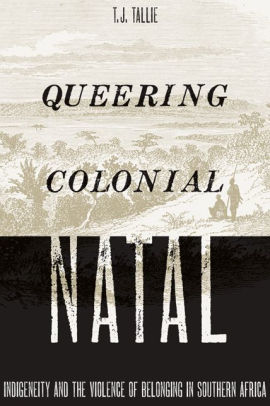
Queering Colonial Natal: Indigeneity and the Violence of Belonging in Southern Africa by T. J. Tallie

This is part of our special feature on Race and Racism in Europe: The Urgency of Now.
As the current pandemic and Black Lives Matter movement reveal, the issue of race has been one of the most salient global issues since at least the 1960s. With Queering Colonial Natal, T. J. Tallie offers a timely work that compels us to revisit how race has been defined since European colonialism in Africa. The book begins with a puzzle of how Europeans in nineteenth-century Natal ruled the region when they were outnumbered by Africans at a rate of nearly one to ten. To address this question, Tallie applies queer theory and takes a refractional approach to show that European settlers have labeled African practices as queer at every opportunity, even though these practices were heterosexual. Their purpose was to justify their own legitimacy and claim civilizational superiority. The queering by the settlers normalizes the white category, creates African and Indian categories as inferior, and, at the same time, distinguishes the role of settler women, African women, and Indian women. Each of the five chapters addresses one dimension, namely ilobolo (the indigenous practice of transferring cattle “from the groom’s family to the wife’s upon marriage”) and polygamy (Tallie 2019, 10), alcohol, friendship, missionary, and education. These five dimensions collectively explain the discourse, reasoning, and strategies used by settlers to establish white heteronormativity and secure access to African labor and materialistic gains in colonial Natal. The book unfolds the layered relationship between settlers, indigenous Africans, and Indians, and presents captivating evidence of how race is not only gendered, but also queered. This is a timely book that tells a compelling story of how past colonialism is still shaping the racial world today, and that the colonial creation of racial categories has always been intersectional, relational, and global.
Cutting across all dimensions is the theme of relationality in the queering of indigenous Africans. Relationality refers to the construction of a social category that relies on its relation to, or contrast with, the construction of another social category or categories. This relationality is unfolded in three layers. First, the presence of Indians in Tallie’s narrative reveals that racial creation in colonial Natal has never been a black/white divide, but rather a trilogy of racial categorization. Indians have been in the picture from the beginning of the settlers’ discourse on race. The tension about how to treat the Indians is discussed in every chapter of the book, making the black/white categorization contested and slippery. Indians’ visibility in resisting and blurring the color line suggests that one cannot fully understand race in colonial Natal without understanding the role of the Indians. The second aspect of relationality is African and Indian agency. Africans and Indians did not readily accept the queering efforts of the colonial government. Instead, they resisted it at every opportunity. For example, the Africans and Indians both pushed for access to greater share of education allocated by the colonial government (Tallie 2019, 165). Interestingly, the Africans and Indians also used the culture of the European settlers to their own advantage. Louisa, an African domestic worker, used God as a legitimate reason to skip work on Sundays to the dismay of her European employer (Tallie 2019, 130). The third layer is the relationality in colonial Natal’s connection with the rest of the world in the late nineteenth century. Race in colonial Natal did not develop isolated from the rest of the world. In fact, the development of the racial discourse and related laws in Natal has always been in dialogue with other regions in the world. The European settlers constantly compared their experience to and learned from settlers in Canada, US, Australia, and the Caribbean.
Tallie offers a rich catalogue of social phenomena, interactions, and processes that are valuable sources for further research. Three potential dialogues between sociological and historical work are noted here. First, Tallie assigns education the role of social capital (Tallie 2019, 152), while sociology commonly understands education as cultural capital, which stems from Pierre Bourdieu who conducted fieldwork in Algeria. The meaning and distinction of education as different forms of capital across different temporal and spatial periods across disciplines could be discussed further in the future. Second, the meaning of the “handshake” as a symbol of “friendship”, as well as the meaning of “friendship” itself between settlers and indigenous Africans could be discussed with more nuance. During the newly appointed bishop, John Colenso’s early encounter with an African person, even if he did manage to grasp the “great black hand” and gave it a “good brotherly shake” as he wished (Tallie 2019, 91), the reader would like to know whether the “handshake” would have shared the same meaning in Natal as it does in Britain. Furthermore, when the exiled Zulu King Cetshwayo kaMpande invoked “friendship” with the British to regain his power over other Africans (Tallie 2019, 99), the reader wishes a better explanation about whether this invocation is Cetshwayo’s adaptation to the British social customs that didn’t exist in indigenous Natal before, or whether this symbol of “friendship” has already existed in Natal before the settlers’ arrival. Third, it is extremely interesting to read why missionaries’ level of success varies from one indigenous African to another. According to Tallie, some were almost fully converted while others were not; or they reverted back to their indigenous ways of life including the manner of dressing and socializing after their conversion. To explain this, Tallie seems to point to the different strengths of social ties owned by individual Africans and how and why such ties can serve as a resistance to missionary conversions in colonial Natal.
One dimension that the book may have downplayed is the gender tension in both African and Indian communities, despite the visibility of these tensions in several chapters of the book. To debunk Eurocentrism, Tallie claims to take an Afro-centric approach that pays attention to multiple non-white observers in his research. Yet African women and Indian women’s voices appear much less frequently and seem weaker than their male counterparts in the narrative. The problematics of this observation are twofold. First, Tallie defends Ilobolo and polygamy against European settlers’ queering rhetoric by arguing that such practices represent a family-unit agricultural production mode that has been developed by the indigenous society to adapt to the veldt. The underlying assumption here is that the structure that exists is the best for the indigenous system. This assumption could certainly be challenged if the structure observes disproportional distribution of status and privilege along gender or other social cleavages. When disproportional distribution does exist, to “whom” the structure is “best” for, and whether all members of the society equally appreciates the structure becomes questionable. The existence of a structure does not prove it the best system for all members in the society and suggests a missed opportunity to discuss underlying inequality. Second, European settlers justify their queering of ilobolo and polygamy by claiming that exchanging African women with cattle is essentially enslavement of the African women by African men. To demystify this claim, Tallie argues that the relationship between African men and African women is in fact more complex than enslavement (Tallie 2019, 19), and that both genders are autonomous. However, Tallie’s portrayal of gender relations suggests otherwise in both African and Indian communities. On the one hand, it was narrated that wealthy and older African men are the greatest beneficiaries of Ilobolo and polygamy because such practices secured their access to African women’s labor and reproductivity, which in turn guards their social status within the indigenous community. African women were also prohibited from attending certain indigenous ceremonies and were segregated if they did attend. During social events, they were also targets of sexual advances by younger African men who acquired wealth. On the other hand, Indian agency was also more dominantly represented by voices of Indian men. Yet the tension between Indian women and men was revealed in the rape of Indian women Subjan by two Indian men, Mootosamy and Apparoo; and Subjan’s resistance against the two Indian men is quite visible in the subsequent court case (Tallie 2019, 82). As these cases show, African women and Indian women were clearly not as “autonomous” as their male counterparts.
The reader observes that Tallie’s selection of observers systematically emphasizes the positions of non-European men but overlooks those of non-European women. While this weakness does not fundamentally undermine the book’s rich evidence and interpretation of European settlers’ attempts to queer Africans and Indians, it misses the point when it idealistically claims non-European women’s autonomy that does not correspond to the gender relations in colonial Natal. While Tallie’s Afro-centric approach as an effort to debunk Eurocentrism is much needed and demonstrates excellent result, the Afro-centric approach, in effect, appears to have been centered around heterosexual African men, and strikes the reader as an overlooked opportunity to further theorize gender in this book. The missed gender issue points out the difficulty that, as long as researchers have a “centric” positionality, their observations might have the consequence of overlooking the inequalities within the center.
All in all, this is a wonderful and important book. It helps the audience understand and redefine contemporary heterosexual normativity beyond colonial Africa and links settler queering of indigenous Africans in Natal with Africa’s anti-gay rhetoric today (Tallie 2019, 188-189). Tallie’s depiction of the heteronormativity and global nature of settler colonization is truly valuable to anthropology, European Studies, and many other humanities and social science disciplines. Anyone who is interested in race in post-colonial societies or want to better understand today’s issue with race should read this book.
Yao Lu is a PhD student in the Sociology Department at the University of California, Davis.
Queering Colonial Natal: Indigeneity and The Violence of Belonging in Southern Africa
By T. J. Tallie
Publisher: University of Minnesota
Paperback / 240 pages / 2019
ISBN: 9781517905187
Published on September 15, 2020.




